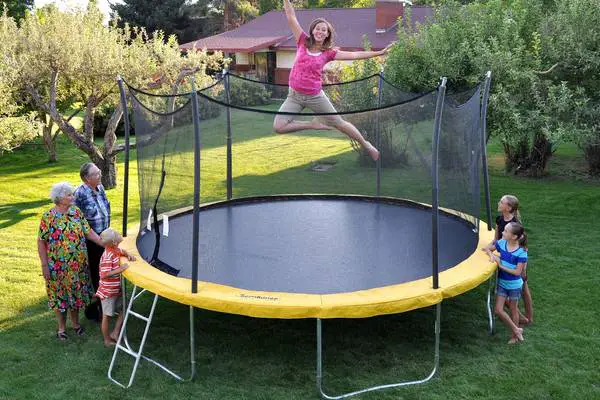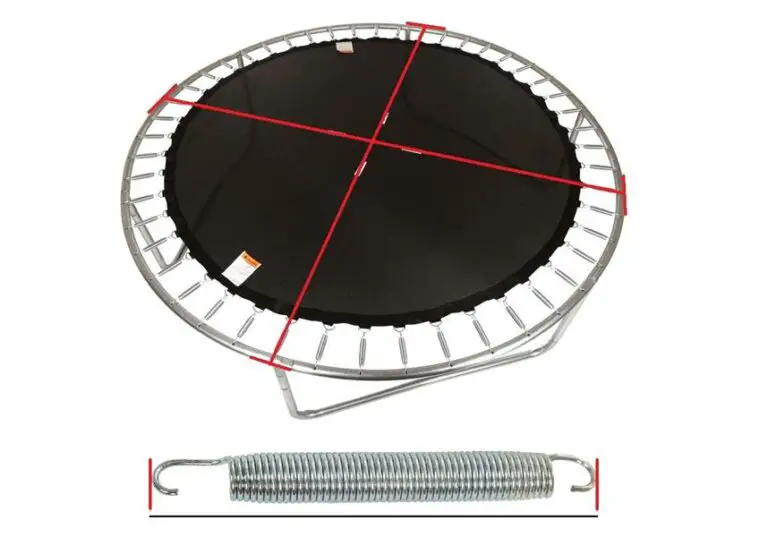Ladies, it’s time to break the stigma surrounding exercise during menstruation! We’ve all heard the myths about what we can and can’t do while on our periods. But the truth is, our bodies are capable of amazing things, even during that time of the month. One question that often comes up is whether it’s safe to jump on a trampoline while on your period. Well, the answer is a resounding yes!
In this article, we’ll explore the science behind menstruation and how it affects our bodies during exercise. We’ll also discuss the benefits of exercise during menstruation and how jumping on a trampoline can actually help alleviate menstrual cramps. Of course, safety is always a top priority, so we’ll go over some precautions to take while jumping. And for those who prefer alternative exercises, we’ve got you covered too. So let’s break the stigma and embrace our bodies’ capabilities, even during our periods!
The Science Behind Menstruation: Understanding Your Body
The menstrual cycle is a natural process that occurs in a woman’s body over an average of 23-38 days. It has three distinct phases: the follicular phase, ovulation, and luteal phase. The follicular stage begins on day one of your period and is followed by low hormone levels while your body prepares for ovulation.
During the follicular phase, you may experience increased energy levels and improved physical activity capacity compared to other times in your cycle. Exercise can be good for the body during this time, but bleeding after exercise could have different causes. If you experience it repeatedly, it may be best to consult with a healthcare provider.
If you’re wondering whether jumping on a trampoline during your period is possible or not, yes! Exercising during and before menstruation can help reduce menstrual pain and improve mental well-being as well. Rebounding on a trampoline is an excellent option since it’s highly effective while being extremely low-impact at the same time – making it easier on joints than other high-intensity exercises like running.
Periods are a natural bodily function and should not hold women back from living their lives fully. Understanding our bodies’ natural cycles can provide some clarity as to how-to navigate exercising through menstruation safely. By staying active through all stages of one’s menstrual cycle, individuals can maintain their overall health throughout the month!
The Benefits Of Exercise During Menstruation
Exercise during menstruation may actually have some benefits for those struggling with menstrual symptoms like cramps. However, it’s important to be mindful of the type and intensity of exercise, as hormonal changes during the menstrual cycle can impact what is best. Light cardio or walking are generally recommended activities, while high-impact exercises like vigorous jumping on a trampoline may cause heavier bleeding.
Despite the potential limitations for more intense exercises during menstruation, regular physical activity can still help alleviate menstrual pain. A low-impact option that offers many health benefits is rebounding, or bouncing on a mini trampoline. This low-impact workout engages your entire body while promoting lymph flow and balance.
It’s important to listen to your body and not push yourself too hard during this time. Exercise can be an effective tool in managing symptoms associated with menstruation, but it should always be approached mindfully and with consideration for individual limitations and preferences.
In addition to gentle exercise practices, there are also other lifestyle changes that can aid in reducing menstrual pain and discomfort such as proper hydration and maintaining a balanced diet rich in anti-inflammatory nutrients like omega-3 fatty acids found in fish, nuts or flaxseed oil. Overall, finding healthy coping mechanisms is essential for managing symptoms associated with menstruation – so why not try introducing some gentle exercises into your period routine?
Trampoline Safety: Precautions To Take While Jumping
Jumping on a trampoline can be a fun and exciting activity for people of all ages. However, safety should always be a top priority to prevent injuries or accidents. Here are some precautions to take while jumping on a trampoline:
Firstly, if you’re jumping on your period, it is safe as long as you take the necessary precautions to prevent discomfort or leakage. Always use a tampon or menstrual cup during your session to ensure hygiene and comfort.
Secondly, it’s important to remember that children six years old and younger should not jump on a trampoline. This is due to their increased risk of injury and not yet being able to control their movements properly. Additionally, no more than one person should be jumping at a time.
Thirdly, pregnant women can still enjoy jumping on the trampoline with proper precautions such as using safety nets and pads while having someone nearby for assistance in case any issues arise.
Fourthly, regularly check the condition of the trampoline for tears or deterioration in material. Make sure there is adequate protective padding in place that cushions hard landings.
Lastly, monitor your activity level while jumping on the trampoline at all times. It’s important to maintain safety measures and observe certain guidelines when using this piece of equipment so as not cause injuries particularly around wrist areas or lower back/knees stimulation
By adhering to these simple but crucial tips, you can ensure that your experience with a trampoline will be both fun and free from injury risks regardless of demographic variables such as age group, pregnancy status or natural body cycles like menstruation.
Comfort And Hygiene: Choosing The Right Menstrual Products
When it comes to choosing menstrual products to use while jumping on a trampoline during your period, it’s essential to prioritize comfort and hygiene. Reusable products like menstrual cups and underwear are great options that should be subsidized and encouraged due to their eco-friendliness. If you prefer traditional options, consider different types of tampons with varying absorbencies or pads for a more comfortable experience.
Regardless of the product you choose, good menstrual hygiene practices are crucial. Proper bathing can prevent infection and excessive bleeding, while wearing breathable clothing can help alleviate discomfort. Pantyliners can also be helpful on light days but must be changed every 4-6 hours or risk causing odor or infection.
It’s worth noting that the feminine hygiene industry is rapidly expanding and expected to grow in the coming years. However, women should always prioritize their needs when selecting products over clever marketing tactics. It’s essential always to wash with warm water during menstruation—something that washing machines handle well for reusable items like period panties.
Finally, if you experience painful cramps during menstruation, vitamin E, B-1,B-6,and magnesium may help alleviate symptoms. And if using pads during heavy flows causes pad rash with prolonged wetness periods ,showering twice a day or changing frequently becomes imperative . With these considerations in mind,navigating through menstruation while enjoying your time on the trampoline can become relatively comfortable without dissatisfaction or heightened stress levels.
Tips For Managing Menstrual Cramps While Exercising
Many women experience menstrual cramps during their period, which can make exercising uncomfortable or even unbearable. However, there are several ways to manage these cramps and still get in a good workout. Here are five tips for managing menstrual cramps while exercising:
1. Take dietary supplements: Certain dietary supplements such as magnesium and calcium can help promote blood flow and relax the uterus, reducing the severity of menstrual cramps.
2. Try yoga poses: Certain yoga poses such as child’s pose, cat-cow stretch, and downward dog can help ease menstrual pain. These poses facilitate blood flow to the pelvic area and also help stretch out tense muscles.
3. Eat anti-inflammatory foods: Foods like blueberries, ginger, turmeric, and leafy greens have anti-inflammatory properties that can help fight cramps.
4. Use heat therapy: Applying heat to the lower abdomen can be just as effective as pain medication in relieving menstrual cramps. A hot water bottle or heating pad is an easy way to apply heat therapy.
5. Exercise regularly: Regular exercise releases endorphins that reduce pain perception and uplift mood during menstruation. Brisk walking is a great exercise option that helps break a sweat without putting too much pressure on the body.
Although exercise may not be appealing during your period due to discomfort from cramping, it is beneficial for overall health and well-being. With the above tips in mind, it’s possible to make exercising more manageable while experiencing menstrual pain. It’s always best for women who experience severe abdominal pains during exercise to consult with their doctor before continuing any physical activity since sometimes it may be related to irritable bowel syndrome or other conditions that need medical attention.
Listening To Your Body: Signs To Watch Out For
While exercising on a trampoline during your period can help reduce pain and cramps, it’s important to pay attention to your body’s signals. Always wear a tampon and use a thin pad to avoid leakage, and avoid heavy days of your cycle. It’s also not recommended to jump for hours on end as this can lead to sudden loss of blood and dizziness.
As you bounce on the trampoline, make sure you follow safety precautions such as keeping the jumping area clear, securing it with pads or nets, and following the manufacturer’s instructions. If you feel any unusual features or severe period symptoms such as heavy bleeding or intense cramps, visit a doctor immediately.
Additionally, listen to signs of pelvic organ prolapse which include feeling heaviness in pelvis or discomfort during sex. Pay attention if pink or red spots show up on underwear as they may be signs of implantation bleeding which is usually not serious.
By paying attention to these signals while jumping on a trampoline during your period, you can ensure that your exercise routine remains safe and healthy while still relieving pain and gaining aerobic benefits from the workout.
Alternative Exercises For When Jumping Is Not An Option
Jump Rope is an excellent option for those who want low-impact aerobic exercise. It offers a full-body workout, improves coordination and balance while burning calories quickly. Walking, swimming, prenatal yoga, or stationary cycling are other suitable forms of low-impact exercise that can keep you moving.
Squats are a great way to warm up the lower body before jumping rope. However, if you have difficulty doing squats, you can modify them according to your needs. Additionally, dumbbell woodchoppers can serve as a medicine ball slam alternative if you don’t want to go too hard on your joints.
Excessive exercise intensity puts pregnant women at risk for Exercise-induced Amenorrhea(losing their periods), and it’s advisable that they try out gentler workouts such as walking and yoga to stay fit without overworking themselves. So when jumping is not an option for any reason, there are still several ways to get moving – find a suitable alternative and jumpstart your fitness journey today!
Breaking The Stigma: Normalizing Exercise During Menstruation.
Exercise is important for maintaining a healthy body and mind. However, there are many persistent social stigmas and harmful misconceptions surrounding menstruation that can prevent women from exercising while on their periods. It is time to break the stigma and normalize exercise during menstruation.
It is important to recognize that menstruation is a human rights issue, as it is often a target for discrimination and humiliation. Despite this, engaging in physical activities during ovulation can improve health and reduce the risks of medical issues. Contrary to popular belief, jumping on a trampoline during menstrual cycles does not cause harm or pose any additional risks.
However, harmful socio-cultural norms, stigma, misconceptions and discrimination still exist around menstruation which must be addressed. Menstruation should not be used as an excuse to avoid physical activity. On the contrary, exercise helps maintain a healthy weight, boosts mood and reduces various health issues.
It’s time to change the narrative surrounding menstruation so that women are empowered to take care of their bodies regardless of where they are in their menstrual cycle. Breaking the stigma will mean openly discussing periods without shame or embarrassment; educating people about why exercise is beneficial; creating safe spaces where women feel comfortable exercising while on their period without feeling judged or uncomfortable. By breaking down these barriers we can encourage more women to engage in physical activities without fear of judgment or embarrassment based on something that occurs naturally within their body every month.
Conclusion
In conclusion, yes, it is safe to jump on a trampoline while on your period as long as you take the necessary precautions and listen to your body. Exercise during menstruation can have many benefits, including reducing menstrual cramps and improving mood. It is important to choose the right menstrual products for comfort and hygiene and to be aware of any signs that your body may need a break.
Breaking the stigma around exercise during menstruation is important for women’s health and well-being. By normalizing exercise during this time, we can empower women to prioritize their physical health and overcome any discomfort or shame associated with menstruation. So go ahead and jump on that trampoline, and don’t let your period hold you back!






